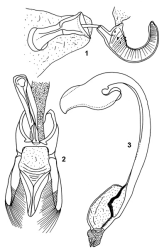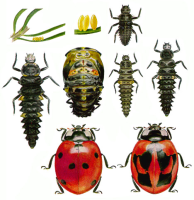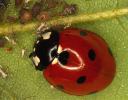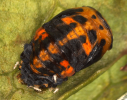Scientific name
Coccinella septempunctata Linnaeus
Common name
Seven-spotted ladybird
Taxonomic position
Coleoptera: Coccinellidae: Coccinellinae: Coccinellini
Diagnosis
Length 5.2-8.6 mm, width 4.0-6.6 mm. Form oval, strongly convex. Head black, with a pair of semicircular frontal spots, one on either side of inner margin of eyes. Pronotum black, with a pale yellow or white anterolateral spot. Ground colour or elytra red, orange or yellow, elytral pattern in typical form with seven black spots-one common spot around scutellum, and three on each elytron, with small whitish patches on either side of scutellum, just above scuellar spot; elytral pattern extremely variable. Ventral side more or less completely black. Last visible abdominal segment with a median bunch of hairs in males, posterior margin emarginate and prominently dented; subtriangular with arcuate posterior margin in females. Post-coxal plates on abdominal ventrite 1 incomplete with an associate oblique line. Female spermatheca (Fig. 1) and male genitalia (Figs.2-3) as illustrated. Larva dark slaty grey to dark brown, with orange yellow or reddish areas.
 Figs. 1-3. Genitalia of C. septempunctata: 1. Spermatheca; 2-3. Male genitalia: 2. Tegmen; 3. Sipho Figs. 1-3. Genitalia of C. septempunctata: 1. Spermatheca; 2-3. Male genitalia: 2. Tegmen; 3. SiphoImages
 Life stages Life stages


 Adult, dorsal view Adult, dorsal view

 Larva Larva
 Pupa Pupa
Distribution
A Palaearctic species, widely distributed almost throughout India and the Oriental
region. North Africa. Adventively introduced in several countries including North America.
Prey / associated habitat
Commonly associated with aphids infesting crops such as mustard, wheat, maize, cowpea,
cotton, sorghum, sugarcane, etc. in very large numbers, especially during winter months in the northern region. HEMIPTERA: Aleyrodidae: Bemisia tabaci (Gennadius). Aphidoidea: Adelges spp., Aphis craccivora Koch, Aphis gossypii Glover, Aphis pomi De Geer, Brevicoryne brassicae (Linnaeus), Cervaphis rappardi indica Basu, Dreyfusia (as Adelges) knucheli (Schneider-Orelli & Schneider) (as Chermes himalayensis Stebbing), Dactynotus carthami Hille Ris Lambers, Hyadaphis coriandri (Das), Lipaphis
pseudobrassicae (Kaltenbach) (as L. erysimi (Kaltenbach)), Mindarus japonicus Takahashi, Myzus ?ornatus Laing, Peregrinus maidis (Ashmead), Pineus sp., Rhopalosiphum nymphaeae (Linnaeus), Therioaphis trifolii (Monell), Toxoptera aurantii (Boyer de Fonscolombe). Cicadellidae: Idioscopus clypealis (Lethierry). Coccoidea:
Drosicha dalbergiae (Green), Diaspidiotus perniciosus (Comstock). Lophopidae: Pyrilla perpusilla (Walker). Psyllidae: Diaphorina citri Kuwayama. LEPIDOPTERA:
Crambidae: Early instar larvae of Chilo partellus (Swinhoe). Noctuidae: Helicoverpa armigera (Huebner). Pollen of wild flowers. Numerous other hosts recorded from India and other parts of the world.
Seasonal occurrence
Collected almost round the year, particularly active during winter in northern states and during July-December in southern India.
Natural enemies
Dinocampus coccinellae (Schrank) and Homalotylus flaminius (Dalman) are common parasitoids of this species. Schaefer & Semyanov (1992) provided a world list and bibliography
of arthropod natural enemies of this species.
Notes
This is the ladybird for many naturalists and perhaps the best known species of the family. It is a highly aggressive coloniser and non-target effects due to its introduction are fairly well documented, particularly in north America. In the USA and Canada, where it was purposely, and possibly also accidentally, introduced, it has become well established and is out-competing native North American coccinellids, including Hippodamia convergens (Gordon, 1985).
References
- Gordon, R.D. 1985. The Coccinellidae of America, north of Mexico. Journal of
the New York Entomological Society, 93: 1-912.
- Gordon, R.D. & Vandenberg, N. 1995. Larval systematics of North American Coccinella L. (Coleoptera: Coccinellidae). Entomologica Scandinavica, 26: 67-86.
- Kapur, A.P. 1962. Geographical variations in the colour pattterns of some Indian Ladybeetles (Coccinellidae: Coleoptera). Part I. Coccinella septempunctata Linn., C. transversalis Fabr., and Coelophora bissellata Muls. Proceedings of the First All India Congress of Zoology
(1959), 2: 479-492.
- Puttarudriah, M. & Channabasavanna, G.P. 1953. Beneficial coccinellids of Mysore-I. Indian Journal of Entomology, 15: 87-96.
- Schaefer, P.W. & Semyanov, V.P. 1992. Arthropod parasites of Coccinella septempunctata (Coleoptera: Coccinellidae): world parasite list and bibliography. Entomological News, 103:
125-134.
- Sudha Rao, V. 1962. The status of Coccinella septempunctata L. and its varieties
divaricata Oliv. and confusa Wied. Canadian Entomologist, 94: 1341-1343.
|